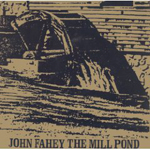|
|
 |
Dusted Reviews
Artist: John Fahey Album: The Mill Pond Label: Important Review date: Dec. 1, 2008 |

|
|
|
 |
No matter how you look at it, The Mill Pond is not a peak of John Fahey’s career. Quite the contrary, it was conceived to break with a past that the guitarist had come to find quite onerous. In 1996, when he recorded these four tracks, his late career reinvention was just under way. Fahey wanted to get as far from a past that contained dauntingly brilliant accomplishments, really bad mistakes, and an extended period wandering in the wilderness of homeless shelters and welfare hotels. He didn’t want to play his old stuff; he wanted to paint and make noise. Originally released as a double 7” on Little Brother records in the spring of 1997, The Mill Pond yielded plenty of the latter. The pressings were crackly, the music amongst the strangest and, in places, ugliest of his career. But since only 1000 were made, it also disappeared quickly and made little impact, especially since the records Fahey subsequently made for Table of the Elements went in a different, less incomprehensible direction. This CD reissue, accomplished 11 years after the original’s release, begs another chance to ponder what Fahey was doing. And its swanky packaging, with a lovely cardboard folio based on the original gatefold and a booklet with 32 color reproductions of Fahey’s painting, demarcates both the links and the breaks between Fahey c. 1996 and Fahey 1939-2001.
The first track “Ghosts” sounds like little else in Fahey’s discography. In fact, with its keening vocal, funereal tempo, and detuned string glissandos, it sounds more like something by Henry Kaiser, Charles K. Noyes, and Sang Won Park’s Korean-American improv trio Invite The Spirit. The presence of Fahey’s voice along sets it apart from 99% of his work, which is instrumental. But another time that he did open his yap – to belt out a farcical Cajun blues on The Voice Of The Turtle – it was to take the piss. And so it is here. Fahey’s high, quavering howls and low, gravelly moans wafting over slack, sprung strumming push spooky so far into parody that you expect him to say “Boo!” at the end. Fahey always hated being the object of reverence, and here he’s the haint in the woods, ready to grab you just as you catch that snipe.
“Garbage” is where Fahey brings the noise. It’s a found sound collage, but he’s subjected those sounds to such blunt-instrument processing (most likely involving the sounds coming out of a speaker at one end of the room and returning to tape via a boombox at the other end) that it’s any guess what they actually are. Big band horns, train wheels, and 101 Strings all swirl by, but they soon sink back into the maelstrom. In his writings Fahey, a former analysand, often trolled the unconscious, most impressively in “Fish,” a story of recovered memories of childhood sexual abuse found in How Bluegrass Music Destroyed My Life. Here, you slog through ten minutes of sonic crud to get to a few seconds of strummed guitar. And like those artifacts of unconsciousness that come out in dreams, it’s open to interpretation. Perhaps Fahey, who at that time was dissing his most-loved music to anyone who would listen, wanted you to think that all that had come before was garbage? Or perhaps it’s a fairly literal representation of the garbage you have to go through in life to get the point where you can accomplish anything, even strum a few notes on a guitar? Or maybe it’s just the sound of a man trying to drown his past in a bathtub. Like any good sphinx, Fahey wasn’t telling.
The other two tracks, “You Can’t Cool Off In The Mill Pond, You Can Only Die,” and “The Mill Pond Drowns Hope,” combine noise, fluid slide guitar, and harrowingly distorted howling to take you back to the spook-house. Only this time Fahey isn’t just pulling your leg, he really wants to raise the hackles. And he does. Some of his paintings in the accompanying booklet Selected Paintings Of John Fahey also represent monsters, but on paper Fahey’s rudimentary technique makes them indistinguishable from a third grader’s Halloween doodles. More interesting are the inkblot images, whose Rorschach-like forms bring us back to the murky stuff of the unconscious. Fahey leaves it to the looker to finish them, and to take responsibility for what they see.
By Bill Meyer
|







